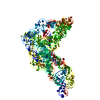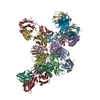[English] 日本語
 Yorodumi
Yorodumi- PDB-5g2y: Structure a of Group II Intron Complexed with its Reverse Transcr... -
+ Open data
Open data
- Basic information
Basic information
| Entry | Database: PDB / ID: 5g2y | ||||||
|---|---|---|---|---|---|---|---|
| Title | Structure a of Group II Intron Complexed with its Reverse Transcriptase | ||||||
 Components Components | GROUP II INTRON | ||||||
 Keywords Keywords | TRANSFERASE / GROUP II INTRONS / RIBONUCLEOPROTEIN / INTRON-ENCODED PROTEIN / RETROTRANSPOSONS AND SPLICEOSOM | ||||||
| Function / homology | RNA / RNA (> 10) / RNA (> 100) Function and homology information Function and homology information | ||||||
| Biological species |  LACTOCOCCUS LACTIS (lactic acid bacteria) LACTOCOCCUS LACTIS (lactic acid bacteria) | ||||||
| Method | ELECTRON MICROSCOPY / single particle reconstruction / cryo EM / Resolution: 4.5 Å | ||||||
 Authors Authors | Qu, G. / Kaushal, P.S. / Wang, J. / Shigematsu, H. / Piazza, C.L. / Agrawal, R.K. / Belfort, M. / Wang, H.W. | ||||||
 Citation Citation |  Journal: Nat Struct Mol Biol / Year: 2016 Journal: Nat Struct Mol Biol / Year: 2016Title: Structure of a group II intron in complex with its reverse transcriptase. Authors: Guosheng Qu / Prem Singh Kaushal / Jia Wang / Hideki Shigematsu / Carol Lyn Piazza / Rajendra Kumar Agrawal / Marlene Belfort / Hong-Wei Wang /   Abstract: Bacterial group II introns are large catalytic RNAs related to nuclear spliceosomal introns and eukaryotic retrotransposons. They self-splice, yielding mature RNA, and integrate into DNA as ...Bacterial group II introns are large catalytic RNAs related to nuclear spliceosomal introns and eukaryotic retrotransposons. They self-splice, yielding mature RNA, and integrate into DNA as retroelements. A fully active group II intron forms a ribonucleoprotein complex comprising the intron ribozyme and an intron-encoded protein that performs multiple activities including reverse transcription, in which intron RNA is copied into the DNA target. Here we report cryo-EM structures of an endogenously spliced Lactococcus lactis group IIA intron in its ribonucleoprotein complex form at 3.8-Å resolution and in its protein-depleted form at 4.5-Å resolution, revealing functional coordination of the intron RNA with the protein. Remarkably, the protein structure reveals a close relationship between the reverse transcriptase catalytic domain and telomerase, whereas the active splicing center resembles the spliceosomal Prp8 protein. These extraordinary similarities hint at intricate ancestral relationships and provide new insights into splicing and retromobility. | ||||||
| History |
|
- Structure visualization
Structure visualization
| Movie |
 Movie viewer Movie viewer |
|---|---|
| Structure viewer | Molecule:  Molmil Molmil Jmol/JSmol Jmol/JSmol |
- Downloads & links
Downloads & links
- Download
Download
| PDBx/mmCIF format |  5g2y.cif.gz 5g2y.cif.gz | 278 KB | Display |  PDBx/mmCIF format PDBx/mmCIF format |
|---|---|---|---|---|
| PDB format |  pdb5g2y.ent.gz pdb5g2y.ent.gz | 222.6 KB | Display |  PDB format PDB format |
| PDBx/mmJSON format |  5g2y.json.gz 5g2y.json.gz | Tree view |  PDBx/mmJSON format PDBx/mmJSON format | |
| Others |  Other downloads Other downloads |
-Validation report
| Summary document |  5g2y_validation.pdf.gz 5g2y_validation.pdf.gz | 630 KB | Display |  wwPDB validaton report wwPDB validaton report |
|---|---|---|---|---|
| Full document |  5g2y_full_validation.pdf.gz 5g2y_full_validation.pdf.gz | 641.4 KB | Display | |
| Data in XML |  5g2y_validation.xml.gz 5g2y_validation.xml.gz | 17.9 KB | Display | |
| Data in CIF |  5g2y_validation.cif.gz 5g2y_validation.cif.gz | 27.7 KB | Display | |
| Arichive directory |  https://data.pdbj.org/pub/pdb/validation_reports/g2/5g2y https://data.pdbj.org/pub/pdb/validation_reports/g2/5g2y ftp://data.pdbj.org/pub/pdb/validation_reports/g2/5g2y ftp://data.pdbj.org/pub/pdb/validation_reports/g2/5g2y | HTTPS FTP |
-Related structure data
| Related structure data |  3332MC  3331C  3333C  5g2xC C: citing same article ( M: map data used to model this data |
|---|---|
| Similar structure data |
- Links
Links
- Assembly
Assembly
| Deposited unit | 
|
|---|---|
| 1 |
|
- Components
Components
| #1: RNA chain | Mass: 227611.469 Da / Num. of mol.: 1 Source method: isolated from a genetically manipulated source Source: (gene. exp.)  LACTOCOCCUS LACTIS (lactic acid bacteria) LACTOCOCCUS LACTIS (lactic acid bacteria)Production host:  LACTOCOCCUS LACTIS (lactic acid bacteria) / References: RNA-directed DNA polymerase LACTOCOCCUS LACTIS (lactic acid bacteria) / References: RNA-directed DNA polymerase |
|---|
-Experimental details
-Experiment
| Experiment | Method: ELECTRON MICROSCOPY |
|---|---|
| EM experiment | Aggregation state: PARTICLE / 3D reconstruction method: single particle reconstruction |
- Sample preparation
Sample preparation
| Component | Name: Group II Intron Complexed with its Reverse Transcriptase Type: COMPLEX |
|---|---|
| Buffer solution | Name: 50 MM TRIS-HCL, 10 MM KCL, 10 MM MGCL2, 5 MM DTT / pH: 7.5 / Details: 50 MM TRIS-HCL, 10 MM KCL, 10 MM MGCL2, 5 MM DTT |
| Specimen | Conc.: 0.05 mg/ml / Embedding applied: NO / Shadowing applied: NO / Staining applied: NO / Vitrification applied: YES |
| Specimen support | Details: HOLEY CARBON |
| Vitrification | Instrument: FEI VITROBOT MARK IV / Cryogen name: ETHANE / Details: LIQUID FREON |
- Electron microscopy imaging
Electron microscopy imaging
| Experimental equipment |  Model: Titan Krios / Image courtesy: FEI Company |
|---|---|
| Microscopy | Model: FEI TITAN KRIOS / Date: Oct 1, 2014 |
| Electron gun | Electron source:  FIELD EMISSION GUN / Accelerating voltage: 300 kV / Illumination mode: FLOOD BEAM FIELD EMISSION GUN / Accelerating voltage: 300 kV / Illumination mode: FLOOD BEAM |
| Electron lens | Mode: BRIGHT FIELD / Nominal defocus max: 3000 nm / Nominal defocus min: 1200 nm |
| Image recording | Film or detector model: GATAN K2 SUMMIT (4k x 4k) |
| Image scans | Num. digital images: 2000 |
- Processing
Processing
| CTF correction | Details: INDIVIDUAL PARTICLES | ||||||||||||
|---|---|---|---|---|---|---|---|---|---|---|---|---|---|
| Symmetry | Point symmetry: C1 (asymmetric) | ||||||||||||
| 3D reconstruction | Resolution: 4.5 Å / Num. of particles: 102522 Details: SUBMISSION BASED ON EXPERIMENTAL DATA FROM EMDB EMD-3332. (DEPOSITION ID: 14254). Symmetry type: POINT | ||||||||||||
| Refinement | Highest resolution: 4.5 Å | ||||||||||||
| Refinement step | Cycle: LAST / Highest resolution: 4.5 Å
|
 Movie
Movie Controller
Controller










 PDBj
PDBj





























